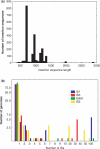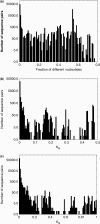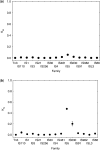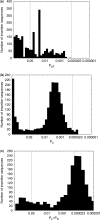A survey of bacterial insertion sequences using IScan
- PMID: 17686783
- PMCID: PMC2018620
- DOI: 10.1093/nar/gkm597
A survey of bacterial insertion sequences using IScan
Abstract
Bacterial insertion sequences (ISs) are the simplest kinds of bacterial mobile DNA. Evolutionary studies need consistent IS annotation across many different genomes. We have developed an open-source software package, IScan, to identify bacterial ISs and their sequence elements--inverted and target direct repeats--in multiple genomes using multiple flexible search parameters. We applied IScan to 438 completely sequenced bacterial genomes and 20 IS families. The resulting data show that ISs within a genome are extremely similar, with a mean synonymous divergence of K(s) = 0.033. Our analysis substantially extends previously available information, and suggests that most ISs have entered bacterial genomes recently. By implication, their population persistence may depend on horizontal transfer. We also used IScan's ability to analyze the statistical significance of sequence similarity among many IS inverted repeats. Although the inverted repeats of insertion sequences are evolutionarily highly flexible parts of ISs, we show that this ability can be used to enrich a dataset for ISs that are likely to be functional. Applied to the thousands of genomes that will soon be available, IScan could be used for many purposes, such as mapping the evolutionary history and horizontal transfer patterns of different ISs.
Figures






Similar articles
-
ISQuest: finding insertion sequences in prokaryotic sequence fragment data.Bioinformatics. 2015 Nov 1;31(21):3406-12. doi: 10.1093/bioinformatics/btv388. Epub 2015 Jun 27. Bioinformatics. 2015. PMID: 26116929
-
OASIS: an automated program for global investigation of bacterial and archaeal insertion sequences.Nucleic Acids Res. 2012 Dec;40(22):e174. doi: 10.1093/nar/gks778. Epub 2012 Aug 16. Nucleic Acids Res. 2012. PMID: 22904081 Free PMC article.
-
ISfinder: the reference centre for bacterial insertion sequences.Nucleic Acids Res. 2006 Jan 1;34(Database issue):D32-6. doi: 10.1093/nar/gkj014. Nucleic Acids Res. 2006. PMID: 16381877 Free PMC article.
-
Insertion sequence diversity in archaea.Microbiol Mol Biol Rev. 2007 Mar;71(1):121-57. doi: 10.1128/MMBR.00031-06. Microbiol Mol Biol Rev. 2007. PMID: 17347521 Free PMC article. Review.
-
IS elements as constituents of bacterial genomes.Res Microbiol. 1999 Nov-Dec;150(9-10):675-87. doi: 10.1016/s0923-2508(99)00124-2. Res Microbiol. 1999. PMID: 10673006 Review.
Cited by
-
TnpPred: A Web Service for the Robust Prediction of Prokaryotic Transposases.Comp Funct Genomics. 2012;2012:678761. doi: 10.1155/2012/678761. Epub 2012 Nov 18. Comp Funct Genomics. 2012. PMID: 23251097 Free PMC article.
-
digIS: towards detecting distant and putative novel insertion sequence elements in prokaryotic genomes.BMC Bioinformatics. 2021 May 20;22(1):258. doi: 10.1186/s12859-021-04177-6. BMC Bioinformatics. 2021. PMID: 34016050 Free PMC article.
-
Antibiotics, Resistome and Resistance Mechanisms: A Bacterial Perspective.Front Microbiol. 2018 Sep 21;9:2066. doi: 10.3389/fmicb.2018.02066. eCollection 2018. Front Microbiol. 2018. PMID: 30298054 Free PMC article. Review.
-
Phylogenetic background and habitat drive the genetic diversification of Escherichia coli.PLoS Genet. 2020 Jun 12;16(6):e1008866. doi: 10.1371/journal.pgen.1008866. eCollection 2020 Jun. PLoS Genet. 2020. PMID: 32530914 Free PMC article.
-
Supergroup C Wolbachia, mutualist symbionts of filarial nematodes, have a distinct genome structure.Open Biol. 2015 Dec;5(12):150099. doi: 10.1098/rsob.150099. Open Biol. 2015. PMID: 26631376 Free PMC article.
References
-
- Siguier P, Filee J, Chandler M. Insertion sequences in prokaryotic genomes. Curr. Opin. Microbiol. 2006;9:526–531. - PubMed
-
- Lohe AR, Moriyama EN, Lidholm DA, Hartl DL. Horizontal transmission, vertical inactivation, and stochastic loss of mariner-like transposable elements. Mol. Biol. Evol. 1995;12:62–72. - PubMed
-
- Capy P, Langin T, Bigot Y, Brunet F, Daboussi MJ, Periquet G, David JR, Hartl DL. Horizontal transmission versus ancient origin - mariner in the witness box. Genetica. 1994;93:161–170. - PubMed
Publication types
MeSH terms
Substances
LinkOut - more resources
Full Text Sources
Other Literature Sources

